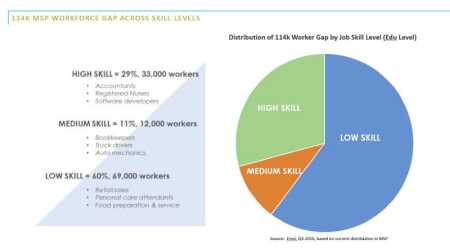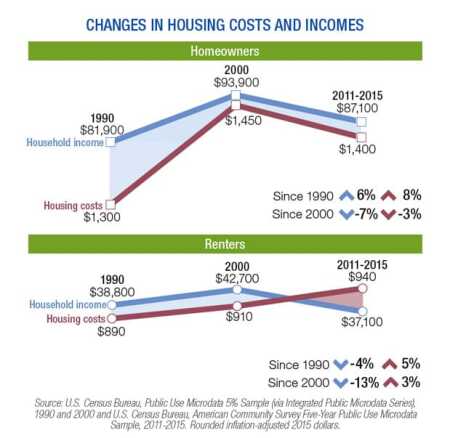The Minneapolis/Saint Paul metropolitan area is a prime example of how strong employment growth is putting a strain on the housing supply available in many U.S. cities. Since 2000, the number of Twin Cities households that face a housing cost burden—defined as spending more than 30 percent of their income on housing—has increased by 25 percent to a total of 199,000 households as of 2015, according to the Metropolitan Council.
Minneapolis/Saint Paul now has one of the lowest unemployment rates in the United States among large cities at 3.4 percent, according to the Bureau of Labor Statistics. The disconnect between where businesses are expanding and where their employees can afford to live was one of the topics addressed at a recent ULI Minnesota event.
“You have this need for workers. You have a growing immigrant population that is going to serve part of that need, and you have a growing native-born population that will serve part of that need. What happens if there is not housing to meet the growing needs of the population?” asked Lisa Sturtevant, senior visiting fellow at ULI’s Terwilliger Center for Housing. Sturtevant discussed findings from her research as published in Home in America: Immigrants and Housing Demand, and moderated a discussion on the jobs and housing mismatch at the recent Housing Summit in Minneapolis.
Forecasts show that the growth in the number of workers in the Minneapolis/Saint Paul metro area will fall short of demand, with a sizable gap of 114,000 workers anticipated by 2020. The majority of those workers—60 percent—are for low-skill and low-pay jobs such as retail sales, food service, and personal-care attendants, according to the Minneapolis Saint Paul Regional Economic Development Partnership.
One solution to not having enough workers nearby has been strengthening transportation options, said Sturtevant. Cities across the country have made significant investments in mass transit systems, including adding or extending bus or light-rail service. “We now have this idea that transportation and housing are two sides of the same coin,” she said.
Housing Affects Hiring
Local companies such as Shutterfly Inc. are already bumping into that worker shortage. About half of the firm’s annual revenue is generated in November and December, and the firm hires a large number of seasonal workers to accommodate that surge in business. “We really saw the stress of the labor market in 2016,” said Jamie Riddle, senior director, manufacturing operations at Shutterfly. The company attempted to bring on 750 seasonal workers at its facility in the south Minneapolis suburb of Shakopee, Minnesota. Although the company filled those positions, it ended up with a high turnover rate at about 40 percent, he said.
One challenge for Twin Cities employers is filling positions that pay less than $20 per hour. Shutterfly has spent thousands of dollars on transportation costs to get people from pockets of the metro area where they live, such as neighborhoods within the city of Minneapolis, to its Shakopee facility. The long commute times also were a factor in the high turnover rate. Although Shakopee does have a significant stock of affordable housing, nothing new has been built recently to accommodate growing demand from new employers such as Shutterfly and Amazon.
FedEx employs 4,000 workers in the Twin Cities and the firm sees an opportunity for that number to rise as its business grows. However, one of the obstacles standing in the way of that growth is finding people, said William Goins, a worldwide account manager at FedEx in Minneapolis and chair of the Minnesota Freight Advisory Committee. FedEx often hires people right after high school or students who are in college. Locating near housing and transportation is very important since many of those workers may not be able to afford a car, he added.
Finding Solutions
Communities do need to engage business stakeholders and develop public/private partnerships to recognize the problems that exist, communicate those problems to the broader community, and then work together to come up with solutions. However, it is easy to say that business and government need to work together. Putting it into practice is more challenging, noted Brad Tabke, former mayor of Shakopee and founder of Grepoli, an advisory firm that coaches communities on economic development success. “So many in the business community don’t want to touch that conversation, because they feel it is a political land mine,” he says.
Businesses are reluctant to get involved in politics, and when they do, it has to be a top-down effort in order to play an effective role in the process. “It is tough to get businesspeople to take time away from their jobs to step up and work with the government,” Goins added. One way to engage the business community is to show that by providing resources, whether that is time or money, there will be a return on investment or a tangible impact on their business, he added.
For many firms, it is not logical or feasible to simply pick up and move operations somewhere else to where there is a better labor supply. “One of the things that we really have to do is have a bigger voice with local governments and state governments,” said Riddle. It also is important for businesses to bridge the gap and engage with those city leaders, get them into a facility, and talk to them about real problems that the business is facing. “It is going to be a harsh reality that, at some point, businesses are going to have to call our governments to the table and say, ‘We will have to leave, because we can’t sustain our business and we can’t grow our business unless these problems are solved,’ ” he said.







